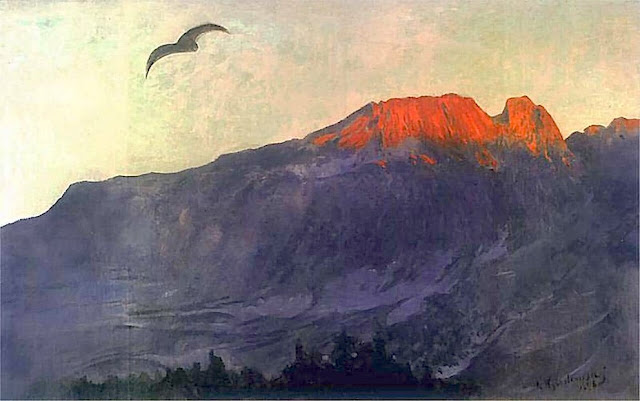Giewont Massif (1, 895 m- 6, 217 ft)
Poland
The painter
Leon Jan Wyczółkowski (1852-1936) was one of the leading painters of the Young Poland movement, as well as the principal representative of Polish Realism in art of the Interbellum. From 1895 to 1911 he served as professor of the Jan Matejko Academy of Fine Arts (ASP) in Kraków, and from 1934, ASP in Warsaw. He was a founding member of the Society of Polish Artists "Sztuka" (Art, 1897). Wyczółkowski was born in Huta Miastowska near Garwolin in Congress Poland. At first, in his artistic experience he aimed at devoting himself to the genre of historical painting with documentary realism in the detail. After his trip to Paris though, he changed his focus and began implementing solutions typical of the French Impressionists. He painted dramatic landscapes, nudes and pastoral scenes with impasto and impressionist lighting effects . For a short while he came under the influence of Symbolism, and around 1900 darkened his palette. His work is characterized by a richness of form and complex technical means. Thanks to a friendship with Feliks Manggha Jasieński, he expanded his interests to include oriental scenes as well. Wyczółkowski was a master of flower arrangements and still life. He portrayed almost the entire art world of Kraków. Wyczółkowski died 1936 in Warsaw. After the war, on the anniversary of his birthday (11 April 1946), the District Museum in Bydgoszcz took up his name in recognition of his outstanding achievements. His widow donated to the Museum many of his paintings, drawings and a lot of personal memorabilia, including studio equipment. The collection, organized into a new department, consists of over 700 works of Leon Wyczółkowski. His most representative impressionist paintings can be found at the National Museum, Kraków and at the National Museum, Warsaw.
The mountain
Giewont is a mountain massif in the Tatra Mountains of Poland. It is 1,895 m - at its highest.The massif has three peaks (all m/metres in AMSL):
- Great Giewont - Wielki Giewont (1,895 m- 6, 217 ft)
- Long Giewont - Długi Giewont (1,867 m- 6, 125 ft)
- Small Giewont - Polish Mały Giewont (1,728 m - 5,669 ft)
There is a mountain pass located between Great and Long Giewont, known as Szczerba (1,823 m- 5, 980 ft). Long Giewont and Great Giewont are situated at a higher altitude than the nearby town of Zakopane, making them clearly visible from that city.
On Great Giewont, there is a 15 m steel cross (erected in 1901) - the site of religious pilgrimages. The area is notorious for its hazardous nature during thunderstorms, so this should be taken into consideration when approaching the summit.
The first recorded ascent to Giewont's summit was undertaken in 1830 by Franciszek Herbich and Aleksander Zawadzki (a19th century explorer). The first winter ascent of Giewont occurred in 1904 by a group of five mountaineers led by Mariusz Zaruski. Nowadays the climbing on Giewont is strictly banned. On the other hand, hiking on the hiking trails is allowed and the access (except the winter) is not difficult hence Giewont is a very popular destination among amblers and Sunday tourists. In the summer up to few thousands tourists a day ascend the top.
_______________________________
2021 - Wandering Vertexes...
by Francis Rousseau




,%20przed%201950,%20Muzeum%20KUL..jpg)

